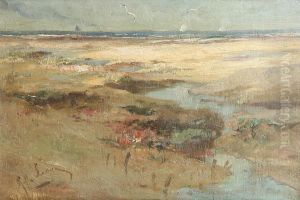Raphael Lagye Paintings
Raphael Lagye was a Belgian artist, born in 1831 in Liège, Belgium, and passed away in 1905. His life and career were marked by his dedication to painting and his significant contribution to the Belgian artistic landscape during the 19th century. Lagye's work was primarily rooted in the Romanticism movement, which was prevalent in Europe during his time. This movement emphasized emotion and individualism, a stark contrast to the previously dominant Enlightenment ideals of reason and order. Lagye's paintings often depicted scenes filled with emotion, nature, and sometimes, historical themes, aligning with the Romanticist ideals.
Despite not gaining the international fame of some of his contemporaries, Lagye's work was well-respected within Belgium and among certain art circles in Europe. He studied at the Academy of Fine Arts in Liège, where he later became a professor. His role as an educator allowed him to influence a new generation of artists, imparting techniques and ideals of the Romantic movement. Through his teaching and his art, Lagye played a part in the transition towards modern artistic expressions in Belgium.
Lagye's body of work includes not only paintings but also drawings and illustrations. His attention to detail and the ability to capture the emotional essence of his subjects were notable aspects of his art. Although specific pieces may not be widely recognized internationally, his contribution to the Belgian art scene and the Romantic movement remains significant. Today, Raphael Lagye's work can be found in various Belgian museums, where it continues to be a subject of admiration for both art enthusiasts and historians alike.




